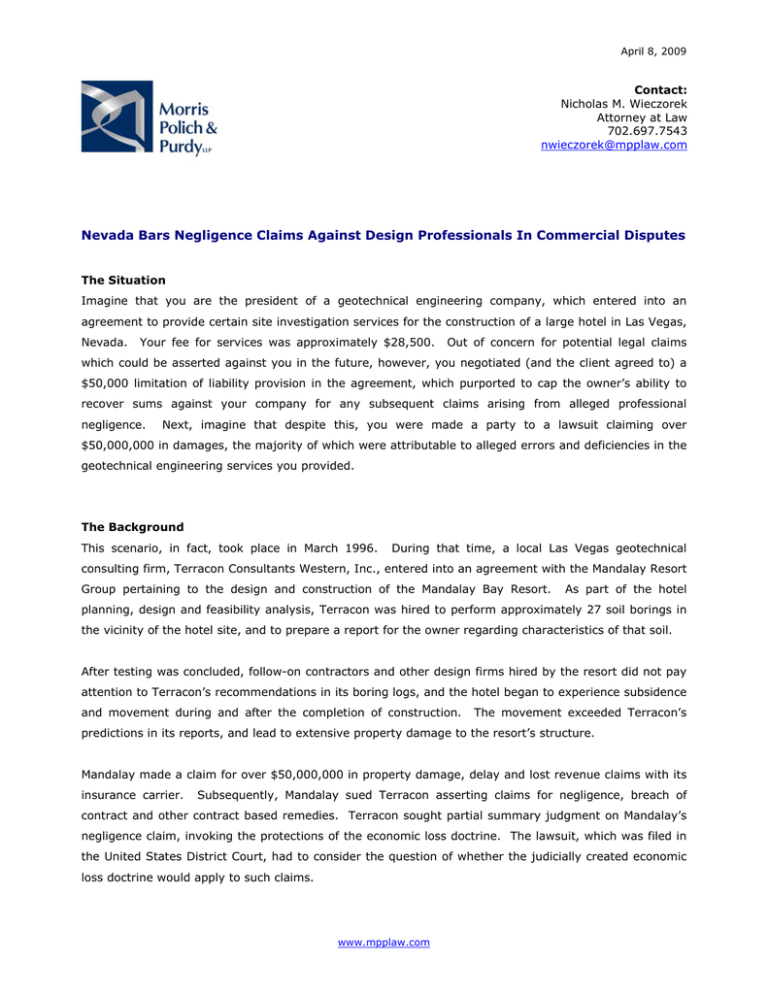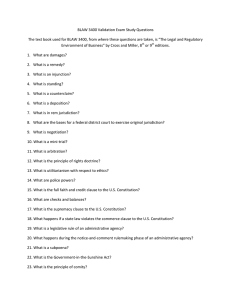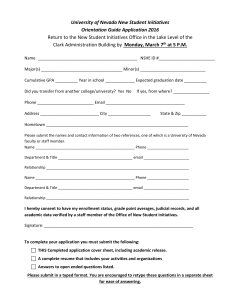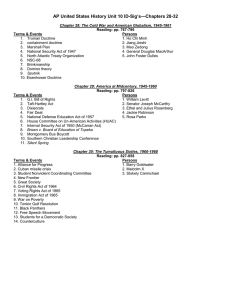Nevada Bars Negligence Claims Against Design Professionals In
advertisement

April 8, 2009 Contact: Nicholas M. Wieczorek Attorney at Law 702.697.7543 nwieczorek@mpplaw.com Nevada Bars Negligence Claims Against Design Professionals In Commercial Disputes The Situation Imagine that you are the president of a geotechnical engineering company, which entered into an agreement to provide certain site investigation services for the construction of a large hotel in Las Vegas, Nevada. Your fee for services was approximately $28,500. Out of concern for potential legal claims which could be asserted against you in the future, however, you negotiated (and the client agreed to) a $50,000 limitation of liability provision in the agreement, which purported to cap the owner’s ability to recover sums against your company for any subsequent claims arising from alleged professional negligence. Next, imagine that despite this, you were made a party to a lawsuit claiming over $50,000,000 in damages, the majority of which were attributable to alleged errors and deficiencies in the geotechnical engineering services you provided. The Background This scenario, in fact, took place in March 1996. During that time, a local Las Vegas geotechnical consulting firm, Terracon Consultants Western, Inc., entered into an agreement with the Mandalay Resort Group pertaining to the design and construction of the Mandalay Bay Resort. As part of the hotel planning, design and feasibility analysis, Terracon was hired to perform approximately 27 soil borings in the vicinity of the hotel site, and to prepare a report for the owner regarding characteristics of that soil. After testing was concluded, follow-on contractors and other design firms hired by the resort did not pay attention to Terracon’s recommendations in its boring logs, and the hotel began to experience subsidence and movement during and after the completion of construction. The movement exceeded Terracon’s predictions in its reports, and lead to extensive property damage to the resort’s structure. Mandalay made a claim for over $50,000,000 in property damage, delay and lost revenue claims with its insurance carrier. Subsequently, Mandalay sued Terracon asserting claims for negligence, breach of contract and other contract based remedies. Terracon sought partial summary judgment on Mandalay’s negligence claim, invoking the protections of the economic loss doctrine. The lawsuit, which was filed in the United States District Court, had to consider the question of whether the judicially created economic loss doctrine would apply to such claims. www.mpplaw.com April 8, 2009 The Economic Loss Doctrine The economic loss doctrine is a legal principle whereby claims against and between parties who are not in a contractual relationship are limited by the courts to remedies available in contract, with the exception of certain bodily injury, misrepresentation and intentional misconduct claims. This judicial construct has the effect of shielding individuals and companies from unfair monetary judgments which may be disproportionate to the level of services provided or the proper allocation of liability. In Nevada, prior case law had established that the economic loss doctrine was valid and enforceable, but its reach had been limited to construction contractors and product manufacturers. With little case authority to go by with respect to Nevada’s interpretation of the reach of the doctrine, the District Court certified a question to the Nevada Supreme Court asking for interpretation of the scope of the economic loss doctrine as it may apply to the services of design professionals. Prior cases had stated that the economic loss doctrine marked a “fundamental boundary” between contract law and tort law. Many states established legal precedent upholding the provisions of the economic loss doctrine, indicating that, in cases involving damages other than for personal injury or misrepresentation, the remedy should be limited to what is set out in the contract between the parties and the contractual expectations of parties should not be left to “drown in a sea of tort.” In Terracon Consultants Western, Inc. v. Mandalay Bay Resort Group, the defendants, as well as other design professional firms which had been joined into the lawsuit, argued that it was contrary to public policy and prevailing law that they could potentially be held responsible for tens of millions in damages arising from contractual services which generated, in most cases, less than $100,000 in actual fee revenue for the design firm. Mandalay argued that design professionals should be treated no differently than attorneys, accountants and other professional service providers, whose activities had been exempted from the reach of the economic loss doctrine. The Decision The Supreme Court, in its March 26, 2009 decision, disagreed with Mandalay’s argument: After examining relevant authority and contemplating the policy considerations behind the economic loss doctrine, we have determined that the doctrine’s purpose – to shield defendants from unlimited liability for all of the economic consequences of a negligent act, particularly in a commercial or professional setting, and thus to keep the risk of liability reasonably calculable – would be furthered by applying it to preclude the professional negligence claims at issue here. Thus, we conclude that the economic loss doctrine bars professional negligence claims against design professionals who provided services in the process of developing or approving commercial property when the plaintiffs’ damages are purely financial. www.mpplaw.com April 8, 2009 Indicating that professional design services are similar to construction contractor services, best analyzed through the contractual relationships, the court stated: In the context of engineers and architects, the bar created by the economic loss doctrine applies to commercial activity for which contract law is better suited to resolve professional negligence claims. This legal line between contract and tort liability promotes useful commercial economic activity, while still allowing tort recovery when person injury or property damage are present. Further, as is in this case, contracting parties often address the issue of economic losses in contract provisions. The Terracon decision does not apply to residential disputes, as economic losses in residential developments are addressed by Nevada's Chapter 40 statutory process. The Effects The Terracon decision falls within the aftermath of an approximately 10-year spike in construction litigation and claims, both residential and commercial, in Nevada. This spike stemmed from rapid growth both in population and corporation citizenship. Architectural and engineering firms, which often negotiated contracts with property owners or developers for small sums and limited scopes of service, found themselves involved in costly litigation with potentially ruinous consequences for their practices. This decision has been widely anticipated since the case was argued in February, 2008, and has been followed closely by numerous national member organizations representing the interests of the design community, including: the American Institute of Architects (AIA), AIA Nevada, AIA Las Vegas, The American Council of Engineering Companies, The American Council of Engineering Companies of Nevada, The Design Professionals Coalition of the American Council of Engineering Companies, The National Society of Professional Engineers (NSPE), The Nevada Society of Professional Engineers, ASFE/The Best People on Earth, The American Society of Civil Engineers (ASCE), and The Nevada Section of the American Society of Civil Engineers. Although long anticipated, the decision will have the immediate effect of curtailing some types of lawsuits against design professional firms, as well as providing great predictability to both professional design firms and their professional liability insurance companies in establishing rates and exclusions for professional liability insurance policies. The court’s apparent deference to the contractual negotiations of the parties, as opposed to general negligence claims, also will allow design firms to effectively control risks in any project through the negotiation of a specific contractual language to anticipate claims, disputes or potential litigation. www.mpplaw.com






